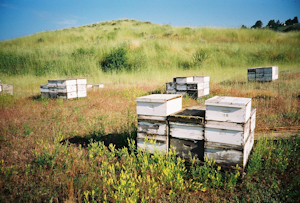Where do Honey Bees Live?
Honey Bees live in nests and these come in a range of forms the most familiar one being a beehive.
But aside from the role of humans in the design of the beehive Bees have and still do create many natural nests in a range of sites. These sites satisfy a range of basic requirements; they are dark and dry, easy to defend and over two cubic feet in size. You can find them in a range of places from tree stumps to dustbins.
The Beehive is basically a box with a simple structure and Bee space which is carefully measured and is designed to be comfortable for the Bees to move around and keep free of obstructions. The Bees are kept on frames which can be removed and examined, after which the Bees settle down quickly.
It's also recommended to stick to one type of beehive so that they are compatible.

Top-Bar Hives
The top-bar or Kenya hives were developed as a cheaper alternative to the standard Langstroth hives and equipment. They are becoming very popular in the United States because of their alignment with biologic therapies, philosophies without many new devotees beekeeping in the United States. They are also very popular due to their simplicity and low cost in developing countries. Top-bar hives have comb mobile and make use of the concept of bee space.
The top bar hive is so named because the bees make their combs a top bar, suspended in the upper part of a cavity, and not in a full rectangular with sides and a bar downstairs. The beekeeper does not provide a wax foundation (or provides only a small piece of the start foundation) for the bees to build from. Bees build shelves so it hangs from the top bar. This is consistent with how bees build wax in a natural cavity. Some believe that the use of natural wax in a top-bar hive supports the natural systems of the bees in order to improve their health. The body of a hive top bar hive is often in the form of an inverted trapezoid in order to reduce the tendency of bees to attach the comb on the walls of the hive body, if this argument has become less popular recently.
There may be more likely that the trapezoidal shape improves the ratio between the weight of the amount of
comb attachment to the bar and helps reduce the risk of heavy combs away from the top bar when manipulated or harvested .
Unlike the Langstroth design, top-bar hive is expanded horizontally, not vertically. The top-bar design is a single case much longer, with the suspension rods in parallel.
Unlike the Langstroth hive, the honey is not usually extracted by centrifuging because a top-bar frame does not have reinforced foundation or a full frame. There is a laterally oriented extractor available, made by Swienty, but they are not too popular in the United States. Because bees have to rebuild their comb honey is harvested after a top-bar hive gives harvest more beeswax honey.
However, like the Langstroth hive, the bees can be induced to store the honey separately from the areas where they are raising the brood. Therefore, bees are less likely to be killed when harvesting from a top-bar hive than when harvesting a hive or other traditional hive design.


